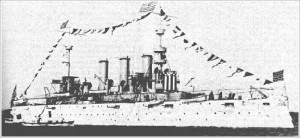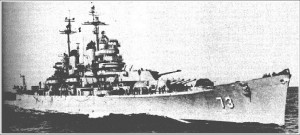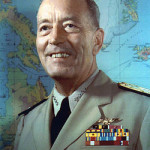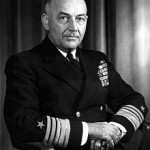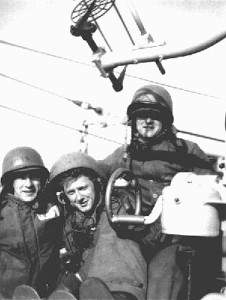The Gray Ghost of the Korean Coast
By Joseph West FC2C (1950-52)
In The Beginning……
HISTORY OF THE THREE SHIPS NAMED ROCHESTER:
The Armored Cruiser New York was renamed Saratoga on 16 February 1911 and on 1 December 1917 was renamed the ROCHESTER Armored Cruiser No. 2 . The name ROCHESTER was given to this ship to allow the name Saratoga to be given to the Battle Cruiser No. 3, eventually to be completed as the famous carrier U. S. S. SARATOGA [CV 3]. The ROCHESTER was redesignated CA 2 in 1930 and served under the name ROCHESTER until 1933 and was then stricken from the navy register in 1935. The ROCHESTER [CA 2] was scuttled in Subic Bay late December, 1941 when Japan invaded the Philippines. Pictured below is the U.S.S. NEW YORK, and U.S.S. SARATOGA.
The second ship destined to be named the “ROCHESTER ” was the U. S. S. ROCHESTER [CA 73]. This ship was renamed the U. S. S. St. Paul on 26 November, 1942. The St. Paul served in the Korean War along side the U.S. S. ROCHESTER
The third and last ship to be named “U. S. S. ROCHESTER” carried the bow number CA 124. The 124 was the only ship of the Oregon City Class to see action and she proved that the single funnel design and lowered superstructure was one of the best designed hulls in the years that the ROCHESTER was in commission.
She displaced 13,700 tons, was 674’11″ in length, 70’ beam, had a draft of 20’7″, crew of 1142, 9-8″, 12-5″, 48-40mm, 20-20mm, and was originally designed to carry 4 aircraft . Later she was refitted to carry helicopters. Also later, the 20mm and 40mm guns were removed and replaced with rapid fire 3″50’s.
The U.S.S ROCHESTER [CA 124] was the third ship in the U. S. Navy to be commissioned with the name ROCHESTER. One of the OREGON CITY CLASS, it was a single funnel cruiser which was designed to reduce the top heaviness cruisers had. In order to obtain these gains the two funnels were compressed into one and the after superstructure was lowered. By reducing the number of funnels and lowering the after decks, they were able to implement more AA fire power and increase the area of AA fire.
Originally eight cruisers of this class were planned but only three were launched before the war’s end. Although the Oregon City was the lead ship of this class it saw very little service. Oregon City, [CA 122] was commissioned 16 Feb. 1946 and decommissioned 15 Dec. 1947. The second ship of this class was the U.S.S. ALBANY [CA 123] was commissioned 15 June 1946 and operated with the 2nd and 6th fleets deployed in the Mediterranean. The Albany was converted to a guided missile heavy cruiser and carried the new ship’s number CG10. The third ship of the Oregon City Class was the U.S.S. ROCHESTER [CA 124] and the only ship of the Oregon City Class to see action.
The U.S.S. ROCHESTER was commissioned 20 Dec. 1946. Subsequent to dock trials and measured runs, the ROCHESTER departed Provinceton, MA. From Feb.47 until Apr. 47, she completed her shakedown cruises off the coast of Cuba. Capt. Harry A. Gutherie, (Annapolis, ’21) in command. On board when leaving for her shakedown cruises were four guests of Navy Secretary Forrestal: Vernon Croop of the Rochester Democrat & Chronicle, Howard Hosmer of the Rochester Times Union, Gunnar Wilig and Charles Silverson of radio station WHEC and WHAM, respectively. During the trip to Cuba the ROCHESTER weathered three separate gales in which 90 knot wind gusts pounded the cruiser. Her toughness saw her through the boiling seas and driving snow and kept her afloat as she rolled 36-37 degrees. Skipper Guthrie, a one-time submariner, stuck to his bridge for four consecutive nights, never even changing his clothes. Executive Officer Commander F. M. Peters Jr., USN, stated, “She rolls like a lamb.”
After completing the shakedown, the ROCHESTER completed a total of 9 training cruises for reservists and midshipmen. In January, 1948, the ROCHESTER prepared for a Mediterranean cruise.
Departing Philadelphia 20 Feb. arriving at Gibraltar 1 Mar. 48, she became the Flagship for ADM Forrest Sherman, Commander 6th Fleet. The ROCHESTER served as 6th Fleet Flagship until she completed her Mediterranean cruise and the flag was transferred to the U.S.S. FARGO. During the cruise time in the Mediterranean the ROCHESTER called on several ports, and waited out the events of the Palestinian crisis, at Suda Bay on the northern coast of Crete.
After the Mediterranean cruise, the ROCHESTER, returned to the east coast and continued training reservists with cruises to Bermuda, New Brunswick, and Jamaica. During these training exercises shore bombardment was conducted at Bloodsworth Island. Then she proceeded to Boston Navy Yard for a refit and was fitted out to carry helicopters. She then operated in the Caribbean and along the North Atlantic coast until she stood out of Narragansett Bay and sailed for a new homeport.
During the training cruises for reservists, the ROCHESTER changed command several times:
- Captain Alexander Junker May 3,1947
- Captain Gordon Josiah Crosby February 24, 1948
- Captain Joseph Worthington December 16, 1948
- Captain Irving Duke December 21, 1949
In January, 1950 she was transferred to the Pacific Fleet. In April, 1950 the Rochester left Long Beach, California for a cruise in the South Pacific. Arriving at Pearl Harbor she took on board CINCPACFL Admiral Radford and departed for a tour of the U. S. Territories. Upon completion of this tour Vice Admiral Struble, Commander, 7th Fleet, was received on board at Guam and sailed to the Philippines.
Vice Admiral Struble, directing the Fleet’s peace time mission, directed large scale training exercises between China and the Philippines. It was during this time that we knew we had a strong naval force in the Seventh Fleet. A fleet that was in fast cruising distance of Korea and was in a high state of readiness. The ship returned to Sangley Point and remained there until President Truman ordered the 7th Fleet into action.
In late June, 1950, the U.S.S. ROCHESTER joined the Carrier Task Force. The ROCHESTER was under the command of Captain Edward L. Woodyard and proceeded to Korean waters. The ROCHESTER was ordered to the West Coast of Korea, carrying the flag of Vice Admiral Struble and operated with TG77.1 Support Force ( RADM W. G. Andrewes, R.N.) consisting of cruiser’s U.S.S. ROCHESTER [CA 124], Capt. E. Woodyard in command, and H.M.S. BELFAST, Capt. Sir Aubrey St. Clair – Foc in command.
The screening destroyers were TG77.2 comprising of SHELTON, EVERSOLE, FLETCHER, RADFORD, MADDOX, S.N. MOORE, BRUSH, TAUSSIG, H.M.S. COSSACK, H.M.S. CONSORT. The Fast Carrier Group TG 77.4 (RADM J. M. Hoskins, U.S.N. ) consisted of the U.S.S VALLEY FORGE and H.M.S. TRIUMPH.
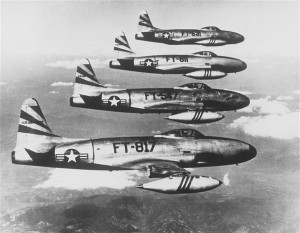 On the morning, 3 July 1950, the first air strikes on North Korea were launched from the carrier group TG 77.4 Forces. After the first day’s strikes, word was received from Commander Naval Forces Far East to continue the air strikes with special attention to targets around the railroads in the following cities: Kumchon, Sariwon and Sinanjo. This marked the first time that naval jets were used in combat.
On the morning, 3 July 1950, the first air strikes on North Korea were launched from the carrier group TG 77.4 Forces. After the first day’s strikes, word was received from Commander Naval Forces Far East to continue the air strikes with special attention to targets around the railroads in the following cities: Kumchon, Sariwon and Sinanjo. This marked the first time that naval jets were used in combat.
With prop driven planes departing first from the carriers, the jets would then be launched and fly higher so as to enable them to arrive at the selected targets about the same time.
17-18 July 1950
The ROCHESTER [CA 124] supported landings at Pohang Dong. and would continue to operate with Task Force 77 until 25 Aug. 1950, as an escort ship for the Fast Carrier Task Force of the 7th Fleet, or as a gunfire support ship. She would sail up and down the coast of Korea supplying the U. N. Forces with the fire support they had requested and also fire on targets in areas occupied by the North Korean Army.
While traveling with the carrier task force, the ROCHESTER would refuel, take on stores and ammunition, while underway. With constant bombardment of the Korean Coast, the crew had little time for sleep or recreation while the ship was on station, often standing four on and four off watches until the crew was brought up to strength with reservists being recalled to active duty. Many of the first reservists called up were petty officers with combat experience from WWII. With the addition of these combat experienced petty officers coming on board the ROCHESTER was able to maintain a high degree of readiness.
INCHON INVASION PLANNED
Plans were now underway to make ready for the U. N. invasion forces to land at Inchon. VADM Struble 7th Fleet Commander aboard his flagship, ROCHESTER, commanding the task force. General Douglas MacArthur and Rear Admiral Doyle were aboard the U. S. S. McKINLEY, the command ship for amphibious landings was in charge of the Amphibious Landing Forces monitored the plans as they began to develop. The plans called for naval shore bombardment to commence on 10 Sept. 1950 with aircraft of Rear Admiral Richard Ruble’s Carrier Division 15 dropping tanks of napalm and flying over Wolmi-Do the next two days to help soften the defenses.
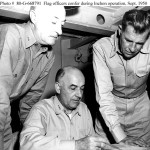
Flag conference on board USS Rochester (CA-124), flagship of Joint Task Force Seven, during the Inchon operation.
Those present are (from left to right):
Rear Admiral James H. Doyle, USN, Commander, Task Force 90,
Vice Admiral Arthur D. Struble, USN, Commander, Joint Task Force Seven, and
Rear Admiral John M. Higgins, USN, Commander, Task Group 90.6.
During the nights the skies were aglow with the fires on shore and daytime the sky was full of heavy black smoke. The destroyers were assigned the task of shelling WOLMI-DO so as to draw the fire from the gun emplacements. After moving in close to the island the North Koreans opened up on the destroyers allowing our spotters to pin – point their positions. Several of the destroyers received top side damage from the shore batteries. The cruisers then opened fire and left the island on fire and neutralizing their positions. Between the shelling from the naval bombardment and the navy and marine pilots WOLMI-DO was reduced to ashes.
 13 Sept. 1950 – 0700
13 Sept. 1950 – 0700
Gunfire Support Group Six, under the command of VADM Struble, aboard the ROCHESTER, moved quietly up the Flying Fish Channel and fired on Wolmi-Do and the mainland of South Korea. Large fires and billowing smoke was seen for miles. Gunfire Support Group Six consisted of U.S. Cruisers TOLEDO, ROCHESTER, H.M.S. KENYA, H.M.S. JAMAICA and destroyers MANSFIELD, DE HAVEN, LYMAN K. SWENSON, GOLIETT, GURKE and HENDERSON.
As the firing commenced on Wolmi-Do and Inchon, reports of the first hits were received and Vice Admiral Struble ordered Captain Woodyard, commanding officer of the ROCHESTER, to heave to and stand by the narrow channel. Admiral Struble wanted the ROCHESTER to be ready to enter and give the destroyers the support that they might need. A few miles south of Inchon the cruisers dropped out of formation, with the ROCHESTER heaving to at the entrance of the narrow channel, and the other ships proceeding to their assigned stations. As the destroyers moved further up the channel the destroyer GURKE struck a mine. The destroyer MANSFIELD then reported that a mine field was present and the cruisers opened fire along with the destroyers to trying to clear the mine field. Fortunately the ships were coming in at low tide and most of the mines could be seen and destroyed. It was during this fire support that calls came to the ROCHESTER to take over the firing from other ships in the TG6. The salvos coming from the ROCHESTER under the control of its Gunnery Officers and Fire Control plot were right on target. The defenses of WOLMI-DO and the mainland targets were nearly all destroyed by the salvos fired by TG6.
After the initial shelling of Korea, the aircraft from our carriers took over and gave the troops ashore close ground support. When the aircraft returned to the carriers we again lit up the sky with salvos from TG6. The tides around Inchon were vary hazardous and the ships had to move back out of the channel to keep from running aground.
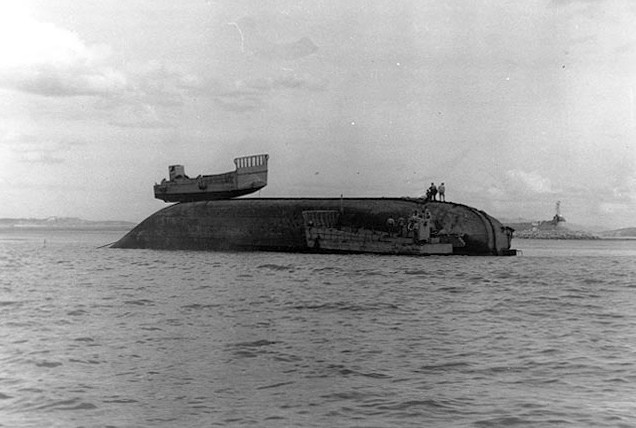
Many books written about this invasion show pictures of several landing ships being high and dry – L.S.T. 789 and a LCM left atop a sunken L.S.T. It was reported that the tide at Inchon was about seventeen feet. When the tide moved out the mud flats moved out a thousand yards.
As the ships moved out of the Flying Fish Channel and out of range from enemy fire, Vice Admiral Struble, aboard his flagship the ROCHESTER, ordered the task force to stop for a conference with his senior officers. They were to report aboard the ROCHESTER, ASAP. Admiral Higgins, his staff officers, VADM Doyle, his staff and Captain Allan of the destroyers came aboard for the conference.
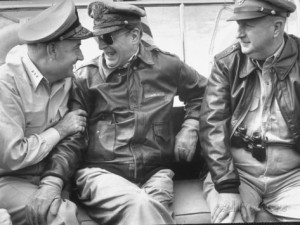 14-15-16 Sept. 1950
14-15-16 Sept. 1950
The Fire Support Group 6 continued their constant bombardment of Korea. On 15 Sept. 1950, VADM Struble departed the ROCHESTER for a conference and to monitor the invasion from the bridge of the Command Ship, U. S. S. MT. MC KINLEY, with General of the Army, Douglas MacArthur, his staff, and RADM Doyle. General MacArthur and VADM Struble departed the command ship and went by small craft to inspect the sea wall area. They assessed the damage done by the naval bombardment and then returned to the command ship.
17 Sept. 1950
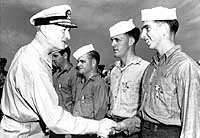
While at Inchon, Admiral Doyle, the amphibious group commander, came aboard to decorate four sailors with the SILVER STAR, for their heroic actions, while they were Cox’ns during the Inchon invasion.
Before daylight, at about 0550, two enemy aircraft, approaching from astern, made a bombing run on the ROCHESTER. They dropped four bombs on their first run that missed astern, except for one bomb that bounced off the crane on the stern and did not explode. The second run on the ROCHESTER missed on the port side, with shrapnel causing minor electrical problems. The Crew then painted a Purple Heart on the crane as a reminder of the close call. The crew of the ROCHESTER suffered no casualties. The attacking planes then turned to attack the H.M.S. JAMAICA, which suffered three casualties before knocking down one of the attacking planes. The other MIG turned tail and left the area.
2 October, 1950
Vice Admiral Struble, aboard his Flagship the heavy cruiser U.S.S. ROCHESTER [CA124], ordered Task Force Seven to be reformed and to prepare for the assault on Wonsan. He stated any further threat to the Naval Forces would come from mines. These were probably old Russian mines that the North Koreans had the capability to launch and were either floating or moored mines. The floating mines were called “DRIFTERS” and, due to the strong tides and currents around Korea, poised a great threat to the naval forces operating in this area.
Oct. – Nov. – Dec. 1950
During these months, the ROCHESTER operated continuously along the eastern coast of Korea providing gunfire support to troops and operating as a mobile helicopter base. During the 10 days preceding the landing at Wonsan, with the Mine Sweepers working in close to shore, the ROCHESTER destroyed six mines by gunfire and assisted in controlling the naval air operations in the Wonsan area . The ROCHESTER roamed up and down the coastal area of Wonsan. The weather turned miserably cold and the men were all issued foul weather gear, long-johns, gloves and face masks. But even with all this foul weather gear it was almost impossible to keep warm with the wind beating down on the men who were standing their watches on deck and while underway.
The JOE POTS were kept hot around the clock, allowing the men coming off watch to warm up a little before turning in. Many of the watches were four on and four off until the ship received more reservists, bringing it up to war time readiness. It was during this time that the ROCHESTER earned the name of “The Gray Ghost of the Korean Coast”. As she moved up and down the coast with her gray hull gliding smoothly over the seas, and with her main and secondary batteries sending the mail ever so deadly upon the shores. Miles inland, “The Gray Ghost” kept a fierce, constant bombardment on the East Coast of Korea. The main targets in this area were factories and the railroad lines. The helicopter from the ROCHESTER flew many missions, spotting for Fire Control and finding various targets in the area. They also flew mercy missions seeking downed aviators from the carriers that were stationed further out at sea, picking them up and returning them to their own ship or bringing them aboard for medical attention. The weather was so cold that a downed airman could only survive a few minutes in the water. Landing the helicopters proved the skill of the pilots, as they attempted to land on the rolling, pitching deck of the cruiser while underway and at high speed.
KOREAS REVENGE STRIKES THE CREW OF THE ROCHESTER!!!!!
The crew became victims of “KOREA’S REVENGE”. Many of the crew became ill with dysentery and this posed a problem , with the limited number of heads on the ship and not being able to get below in time if they were on watch. Men that had more severe cases were admitted to sick bay while those with milder cases had to remain ready to stand their watches. At mess call, the corpsmen would stand at the head of the chow line and hold a large bucket and every member going to chow dipped their hands into the bucket to disinfect them. The men with light cases had to line up and receive anti-biotic’s from the “Doc” and this went on until each man had taken 60 doses. The word was, the ship had received some bad fruit and the bacteria came from the fruit. Some of the crew had to be admitted to sick bay for a second time because they never recovered fully from the first bout of the dysentery.
November, 1950
With Thanksgiving approaching and the news of the speedy advance of our troops, we were looking forward to be heading home soon, thinking that the North Korean Army would soon surrender and we would be home for Christmas. The officers and men of the ROCHESTER enjoyed their holiday dinner
and were all going around telling each other their plans and what they would be doing back in the good old U.S.A. for Christmas, 1950. The ship continued to maintain a high state of readiness and manned their Condition III watch stations. During this time on the east coast of Korea, the weather turned bitterly cold. Standing four hour watches under these conditions proved that the crew was prepared to do their duty. They did so without grumbling…maintaining their composure and working together as a crew should.
The following “Plan of the Day” was submitted by Bob Walker, “T” Div ’48-52.
Plan of the Day, Sunday, 26 Nov. 50
Save Fresh Water
Condition III will be set
UNIFORM: Officers & CPO’s: Working Khaki; Enlisted Personnel: Clean Dungarees; or Undress Blues (Optional) with watch caps if desired.
Fresh water consumption, Friday 24, Nov. 50 – 27,194 gallons.
0400 Call duty cooks
0545 Call Duty MMA
0600 All Hands
0625 General Quarters for dawn alert
0725 Sunrise, Light Ship, Set Condition III
0730 Pipe to breakfast, pipe sweepers
0800 Muster on stations, submit reports to Administrative Office
0900 Catholic Mass in forward Port Messing Compartment
0945 Send boat with Chaplain Garr to USS HENRICO to obtain Chaplain from Henrico for return to
Rochester. MIB for Guard Mail, O.M. Mail and US Mail to SOPA (USS HENRICO)
1015 Protestant Divine Services in forward Port Messing Compartment
1100 Medical inspection of Mess Cooks in the Starboard Messing Compartment
1130 Pipe Sweepers
1200 Pipe to Dinner
1330 Movies in the forward Port Messing Compartment; “The Fighting O’Flynn” with Douglas Fairbanks and Helone Carter
1500 MIB for Guard Mail and US Mail to SOPA (USS HENRICO)
1515 Afternoon News
1545 Mess Gear
1600 Pipe to Supper
1630 Pipe Sweepers. All divisions make your sweepdown reports to the MAA Office
1710 Sunset, Darken Ship, Dusk AA Defense
1800 Movies in the forward Messing Compartment; “The Fighting O’Flynn” with Douglas Fairbanks and Helone Carter
1810 Set Condition III
1830 Bible Class in the Intelligence Office
1900 On Deck all eight o’clock reports
1930 Movies in the wardroom; “Iroquois Trail” with George Montgomery and Brenda Marshall.
1945 Movie in the forward Port Messing Compartment; “The Fighting O’Flynn” with Douglas Fairbanks and Helone Carter
1945 Movies in the aft Port Messing Compartment: “So Young, So Bad”, with Paul Henried and Catherine McLeod.
TAPS Followed by evening prayer after completion of movies
The following interdivisional transfer is effective this date: O’CONNELL, GMC from F Division to 4th Division.
(Navy Press Release) It was not long after the last of the Thanksgiving Turkey had disappeared that the urgency of the war made itself known aboard the heavy cruiser USS ROCHESTER operating in the Wonsan area of North Korea. A gunfire mission on enemy guerillas closed out a Holiday spent keeping alive the great American Tradition of giving thanks for the blessings bestowed upon us, Holy Services were held during the day in which many worshippers from other craft took part. The Ship continued to give support to mine sweeping operations with its Helicopter while the Thanksgiving dinner was prepared. Gun crews were ever so vigilant for the threat of enemy sneak attacks. Throughout, the men gave thanks, thanks to God for the protection they received from the dangers of the sea and violence from the enemy. It had been a long and hard five (5) months since the call to action brought the ship north from the Philippines. The ROCHESTER’S current operations along the Korean coast have extended well into the third month with only one short overnight stay in a Japanese port. The ship has operated as a unit of Carrier Task Forces, Amphibious Forces, gunfire Support Groups, and Mine Seeping outfits. She has served as Fleet Force and Group Flagship. During these months in the service of the United Nations the Cruiser ROCHESTER has steamed more than 25,000 miles, fired more than 1,500 rounds from her main battery in over 75 gunfire support missions against enemy forces. She has controlled the air stikes of upwards of 100 planes a day in their blows against the North Korean Forces. The ROCHESTER’S Helicopter has assisted minecraft in discovering and clearing many mine fields containing hundred’s (100’s) of mines. Services to smaller vessels ranging from providing fuel, food, stores and ammunition, to laundry and boat repair have been rendered by the ROCHESTER. The Ship’s Company could rightly thank God for the privileges of striving for His kind of world. They have, with God’s blessing, seen their own efforts and exertions contribute to the triumph of Godliness over UnGodliness, the triumph of the United Nations over Communism.
T. R. VOGELSY
COMMANDER, U.S. NAVY
EXECUTIVE OFFICER
End of Plan of the Day
CHINA ENTERS THE WAR
We learned that the Chinese had entered the war and were moving southward toward the U. N. Forces. This news brought moans and groans from the crew. The ship again turned northward and again “The Gray Ghost of the Korean Coast” headed back into battle.
December, 1950
The ROCHESTER was called upon to give our troops the fire support it needed and sped to the coastal area of Hungnam, to aid in the evacuation at the port of Hungnam, Korea. It was during this time that the cruisers of the navy showed their firepower. The cruisers St. Paul and ROCHESTER, along with destroyers and LSMR’s, took up stations where they could give support and give the retreating U. N. troops the heavy naval gunfire that this group of ships could deliver, at long distance, inland.
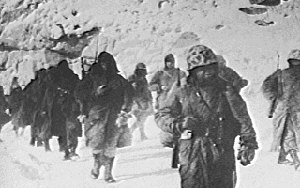 Naval gunfire was not called for by the retreating troops until about the middle of Dec., 1950. When the retreating troops called for support, the cruisers responded with deadly accuracy and hitting targets over ten miles inland. ( Many stories and tales of the BB Missouri’s feats will be told). It was just a couple of days before Christmas and the Mighty MO was called upon to give support to the U. N. Troops and to fire on road targets in the vicinity of ORI – RI and HUNGNAM at the request of an Army General., VADM Doyle was quoted as saying at that time ” Her fire power wasn’t really needed, the cruisers had the situation well in hand, but to satisfy the General’s request he then gave the “MO” a target area and almost immediately the Army spotter for the “MO”, reported, ” it was a direct hit on an enemy troop shelter and that they were running out of and away from the buildings”. The “Mighty MO” was then assigned the task of firing “Illumination” from her secondary battery and to give “harassment” fire support, from her main battery, as called for. When the Army’s artillery was loaded aboard the departing ships in the harbor, around Christmas time, the naval forces in the area took over and fired all the heavy gunfire support as called for and needed.
Naval gunfire was not called for by the retreating troops until about the middle of Dec., 1950. When the retreating troops called for support, the cruisers responded with deadly accuracy and hitting targets over ten miles inland. ( Many stories and tales of the BB Missouri’s feats will be told). It was just a couple of days before Christmas and the Mighty MO was called upon to give support to the U. N. Troops and to fire on road targets in the vicinity of ORI – RI and HUNGNAM at the request of an Army General., VADM Doyle was quoted as saying at that time ” Her fire power wasn’t really needed, the cruisers had the situation well in hand, but to satisfy the General’s request he then gave the “MO” a target area and almost immediately the Army spotter for the “MO”, reported, ” it was a direct hit on an enemy troop shelter and that they were running out of and away from the buildings”. The “Mighty MO” was then assigned the task of firing “Illumination” from her secondary battery and to give “harassment” fire support, from her main battery, as called for. When the Army’s artillery was loaded aboard the departing ships in the harbor, around Christmas time, the naval forces in the area took over and fired all the heavy gunfire support as called for and needed.
LAST DAYS AT HUNGNAM
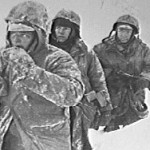 Fires were started on shore to destroy any thing and everything that might fall in the hands of the advancing Chinese Army. During these cold winter days the men who had GQ Stations outside, never grumbled or complained. The men, I knew, who stood these watches aboard the ROCHESTER were proud to be of what little help they could be and prouder yet of our MARINES , who as they were retreating toward Hungnam brought their wounded and dead back to the waiting ships in the harbor. Men looking through the powerful range finders in the secondary battery’s directors were able to see jeeps, loaded with the wounded and dead, strapped across their hoods, men carrying hastily prepared stretchers, or two men, with a wounded comrade between them, helping them to make their way back down the twisting winding mountain roads toward the harbor and to safety in freezing, bitterly, cold weather.
Fires were started on shore to destroy any thing and everything that might fall in the hands of the advancing Chinese Army. During these cold winter days the men who had GQ Stations outside, never grumbled or complained. The men, I knew, who stood these watches aboard the ROCHESTER were proud to be of what little help they could be and prouder yet of our MARINES , who as they were retreating toward Hungnam brought their wounded and dead back to the waiting ships in the harbor. Men looking through the powerful range finders in the secondary battery’s directors were able to see jeeps, loaded with the wounded and dead, strapped across their hoods, men carrying hastily prepared stretchers, or two men, with a wounded comrade between them, helping them to make their way back down the twisting winding mountain roads toward the harbor and to safety in freezing, bitterly, cold weather.
Many of the more able bodied men had taken off their warmer clothing and given them to their wounded and frost-bitten buddies. You had to be there, to see it and to understand the “HORRORS” of battle, and say a prayer for those men working their way back toward the safe harbor . Those of us aboard the ships were cold standing the watches, so we could only think of how cold they must have been.
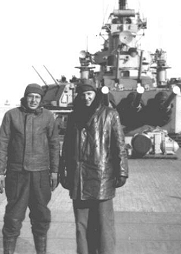
Cotton Blaine, on right, with shipmate while stationed off the coast of Hungnam, Korea. Taken while
standing on the fan tail of the ROCHESTER CA124 during the cold weather.
We could at least get a warm cup of coffee, and take a hot shower to warm up after coming off watch. Those poor GI’s and Mud Marines only had the cold to look forward to and the hope that they could make it back to the beach and get picked up before they froze to death or were captured.
We learned that one of the Admirals had ordered all the ships that had brought men and supplies to Korea, to remain in the area, be ready to receive the wounded, the troops and equipment for evacuation. Several of the transport ships in the evacuation took aboard nearly twice their normal troop capacity. What couldn’t be brought aboard the ships was burned and destroyed so that the advancing enemy troops would not be able to use the ordinance. Standing watches topside you could see and hear the large explosions as they destroyed and burned the equipment.
The ROCHESTER continued to serve with the task force until 10 Jan., 1951, when after 198 straight days at sea, the ” Gray Ghost of the Korean Coast” was ordered to return to Sasebo, Japan, giving its crew their first liberty in 198 days. During its operations of those 198 days, the ROCHESTER had expended more shells than any other ship. The “Gray Ghost” had destroyed many enemy targets and had discouraged the North Koreans from sending its junks or sampans out to fish or to try to lay mines in the area where our ships were operating. It was the constant harassment fire from the main and secondary batteries that kept the North Koreans far inland from the coastal area. During the 198 days at sea off the coast of Korea “The Gray Ghost of the Korean Coast” expended 3,265 – 8″ and 2,339 5″ shells.

This sign greeted the crew at Sasebo, Japan when they went ashore for liberty and it was the first and last stop for many of the crew
Leaving Sasebo and sailing to Honolulu, the ROCHESTER was accompanied by 2 ships and a submarine, (the destroyer Maddox, [PCE – C 896], and the Submarine Diodon). Upon their arrival at Pearl Harbor they were greeted by dancers, and bands. The men lined the decks to enjoy the welcome.
The crew received liberty and enjoyed being welcomed home after so long at sea. After a few short liberties and a few work parties replenishing stores, ROCHESTER left the islands and sailed into Long Beach, California, her homeport.
February, 1951
ROCHESTER left Long Beach and sailed up the coast, entering the ship yards at Mare Island, for a long over-due overhaul. Men who were married were able to bring their families to Mare Island and lived off the ship while the overhaul was taking place. These men returned daily to work while the ship was in dry dock, but were able to be with their families every night. Mare Island had a large camp of huts that had been converted to married housing. This village of huts bore the name “IWO JIMA VILLAGE”. It was here, that many of the wives and crew made new and lasting friendships that have lasted over 40 years
After the overhaul the ROCHESTER was once again ready for sea. Before leaving the Mare Island area the members of the crew who were married and had family in the area could bring their family aboard for an afternoon cruise and dinner. It was a chore to keep a lot of 2- and 3-year old kids from getting to close to the side rails. Getting them to enjoy eating off of trays in the mess hall was something most of us will never forget. They were too small to see what was being put on their trays to eat and the mess cooks serving the meal gave out extra large portions. One thing the kids did enjoy was the extra large portions of ice cream and cake that they received. This was the first time that many of the sailor’s wives got to enjoy the daily feast from our mess cooks. None of the women on board got sea sick, nor did they get their sea legs. The trip in the harbor provided smooth – calm seas for them to enjoy.

Linda Lynn, Daughter of Richard and Virginia Lynn, and Joseph West II (this site’s webmaster), son of Joseph and Beatrice West. Both dads were in the Fox Division. These youngsters were 2 years old.
A few days later we proceeded to take on stores and then moved out to Port Chicago to take on ammunition. We then went south to Long Beach, where we had a ships party and several weeks of liberty. Then further south to San Diego, and there many of our experienced men were transferred to ships just coming out of the reserve mothball fleet. Again took on more reservists and men just out of
boot camp for training. After daily shakedown and training cruises we were once again ordered to join WestPac and left for Pearl Harbor. At Pearl Harbor we took on more stores and new men arrived on board bringing the crew up to full strength. After several short training cruises around the Islands we set sail for Japan. Arriving at Yokosuka, Japan in November, 1951, the crew had a few short liberties before the ROCHESTER once again set sail for the Coast of Korea.
“THE GRAY GHOST OF THE KOREAN COAST” RETURNS
Arriving off the coast of Korea on 28 Nov., 1951, she again opened fire on Kosong with over 250 rounds from her 8″ guns. The North Koreans soon realized that the ship named ” The Gray Ghost of the Korean Coast” had returned to haunt them with it’s continuous shelling of the coast. The “Gray Ghost” sailed up and down the coast of Northeastern Korea, shelling and destroying targets, while her helicopters flew many rescue missions for Task Force 77 aviators. In early April the “Gray Ghost of the Korean Coast” sailed a week as Flagship in charge of blockading the West Coast of Korea. It was during this period of time Nov. 1951 to Apr. 1952 that the battleships and cruisers of task forces 77 and 95 were assigned the difficult task of destroying coastal targets. The battleships were assigned targets that were approximately 16 miles inland and the cruisers were assigned targets that were approximately 10 miles inland. What made these targets difficult was the fact that many of the targets were behind large mountains. Over a period of several months the ships hit their targets with deadly accuracy. The Battleship WISCONSIN, on 43 missions, fired 977 – 16″ projectiles at targets 16 miles inland. They were credited with KIA 70, Wounded 350, and many hits on enemy displacements. The cruisers of the combined task force, ST. PAUL, and ” The Gray Ghost”, ROCHESTER, fired over 1,661 round of 8″ projectiles with the record of KIA 239, wounded 47, and many shore line displacements destroyed. Again, the difficulty of these targets was having to fire over coastal mountain ranges. The weather during these winter months was very cold and made working topside a challenge. Even during the cold winter months the teak wood decks of the ROCHESTER received the regular holy-stoning by the deck divisions, keeping ” The Gray Ghost” a first class fighting ship of the U. S. Navy.
April, 1952
The end of April 52 found the ROCHESTER steaming toward her home port, Long Beach, CA. She then sailed northward to Mare Island Shipyard. There she was refitted with new types of radar and had her ordinance updated.
November, 1952
The ROCHESTER steamed again to the far East for her third tour of combat duty with the Fleet of WestPac. Joining with Joint Task Force 77.1 on 7 DEC., 1952, she spent the winter months in harassment and interdiction missions, operating at times with the Fast Carrier Task Force. It was during this tour of duty that the ROCHESTER fired over 7,000 rounds of five-inch and eight-inch projectiles.
January, 1953
Shortly after the First of January, 1953 the ROCHESTER made a goodwill stop in Saigon. At the time of this trip up the Saigon River, the ROCHESTER was the largest ship to ever go to Saigon. The ship needed 26′ of water and the entrance to the Saigon River was only 26-1/2′ at high tide. The approach to the river had to be made at that precise time. The OOD, Donald Kaiser, had just qualified for that duty on the ship’s trip from Hawaii that previous fall. The Captain and the pilot made the entrance to the river right on time and the ship proceeded to Saigon. Before mooring, it was decided to turn the ship around. Since the river was narrow at that point, there was no alternative except to nose the ship against a mud bank on one shore. The bow was placed in the mud bank and tugs pushed the stern around, so that the ROCHESTER would be facing downstream. The OOD, again Donald Kaiser, states that he believes that he is the only officer to enter into a ship’s log that the ship was run aground in order to turn around. He also said that the pilot who came aboard spoke only French, but that posed no problem as Capt. Phillips spoke that language perfectly.
After this tour of duty the ROCHESTER steamed back to her home port, arriving in Long Beach 6 April, 1953. During her scheduled yard repairs at Mare Island, May 1953, her 20mm’s and 40mm’s were replaced with rapid fire three inch – fifties. ROCHESTER served several more tours of duty operating with WestPac in 1957.
June, 1957
……..found the ROCHESTER in San Francisco where she was the Flagship for Admiral Chester Nimitz. After serving as Flagship for ADM Nimitz the ROCHESTER sailed on two more WestPac tours, making a total of eight Westpac tours for “The Gray Ghost of the Korean Coast”. Rochester served several more tours of duty operating with WestPac.
3 Sept. 573 Sept. 57
At 0924 the Rochester got underway from Long Beach Naval Shipyard, en route to Pearl Harbor, in company with CRUDIV 5 (USS LOS ANGELES, CA135 and USS ROANOKE (CL 145)
7 Sept. 57 7 Sept. 57
Moored at Pearl Harbor.
8 Sept 57
Underway from Pearl Harbor enroute to Sydney, Australia in company with CRUDIV 5.
11 Sept. 57
The Rochester fired a 3 gun salute as King Neptune and the Royal Party came aboard to initate all Pollywogs. The Rochester crossed the equator at 1335 this date. As entered the log 13, Friday did not exist.
12 Sept. 57
The XO delivered a memorandum to all hands. This memorandum stated to all hands on how to act while on liberty in Australia.
18 Sept. 57 1121
Rochester moored at Circular Quay East, Sydney, Australia. The crew enjoyed their time in Australia and on 24 Sept. 57 got underway from Sydney, Australia en route to Yokosuka, Japan in company with CRUDIV 5. -Arriving in Yokosuka 5 Oct. 57.
6 Oct. 57
VADM Wallace M Beakley broke his flag on the Rochester. Seventh Fleet Staff transferred from USS HELENA CA75 to Rochester.
3 Nov. 57
At 0800 Full Dress Ship in honor of Japenese Culture Day.
14 Nov. 57
Encountered Typhoon ” KIT ” at 0532 The Rochester suffered a 5 inch crack, main deck, portside, frame 84. Port accommodation ladder was bent, and steps broken, securing straps on rubber boats 96, 98, 100, 103 were broken.
15 Nov. 57
Moored at Hong Kong, VADM Sir Gerald Gladstone, Royal Navy, came on board, paid and official visit on VADM Beakley.
22 Nov 57
Departed Hong Kong destination Saigon. This was to be the Rochester’s second trip up the Saigon River.
25 Nov. 1957
The Rochester headed up the Saigon River to give the French, in Indo China, a show of support. Once again the bow of the Rochester had to be placed on a mud bank and with the aid of tugs she was turned around to face down river. We then docked at Port de Guerre, the crew took advantage of this port for liberty and relaxation.
CHRISTMAS Dec 25, 1957, 1200:
All Hands of the ROCHESTER TURNED TO TO PLAY SANTA CLAUS. The crew of the Rochester played host to orphans from Sibo Aiji-en Orphanage, Yokohama and Fuku Ben-Kai Orphanage, Zushi City for Christmas Dinner.
28 Dec. 57
His Emminence Francis Cardinal Sellman came aboard to say mass for SEVENTHFLT members and dependants. He remained on board for the noon meal with the crew.
31 Dec. 57
Received an accident report that Griffin, R.L., SN, USN , who while dancing at the NEW FUKUSUKE BAR AND GRILL, ran into a stairway, suffering a laceration on the right eye.
10 Jan.58
Change of command Ceremonies. Captain John S. Coye arrived aboard for his new command and Captain John A. Webster was piped over the side.
“A GREAT SHIP IS DECOMMISSIONED”
The ROCHESTER was decommissioned 15 August 1961 and placed in the reserve fleet.
Struck from the Navy List on 1 Oct. 1973, it was scrapped, removing the ships name
“ROCHESTER”
from the active and reserve fleet of the Navy.
“THE GRAY GHOST OF THE KOREAN COAST”
LIVES ON IN THE MEMORY’S OF THE SHIP’S CREW
The ROCHESTER was called many nicknames by its crew, “The Roach”, “The Roach Catcher”, but the name that best described this valiant ship ” THE GRAY GHOST OF THE KOREAN COAST” will live in memories of her crew who were proud to have served on such a gallant, fighting ship. Ever ready to serve the world in its defense of FREEDOM.
The U. S. S. ROCHESTER [CA 124] earned SIX Battle Stars for her action during the Korean War. The men that served on the “Gray Ghost of the Korean Coast” have formed an association and hold a ship’s reunion every two years. Our next reunion will be in Nashville, Tenn., the fall of ’98.
At the reunion held in ROCHESTER, NY 12 – 14 Oct. 1996, former crew members and their families visited the Museum of Science in ROCHESTER, NY and saw a large scale model of the ROCHESTER, her commissioning bow banner, helm, and ships bell. Also, there were pictures of the first ship named the ROCHESTER [CA 2], that was scuttled off the coast the Philippine Islands. ROCHESTER [CA2], while laying on the bottom, served by not allowing easy passage to the Islands


